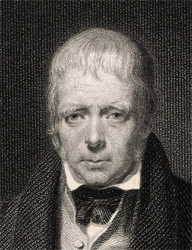|
|
Home | Corson Collection | Biography | Works | Image Collection | Recent Publications | Correspondence | Forthcoming Events | Links | E-texts | Contact Sir John Watson Gordon's 1830 Portrait of Sir Walter ScottThe three-quarter length portrait painted by Sir John Watson Gordon in 1830 presents Scott in full face and seated with his hands resting on his walking stick. He is wearing a dark green coat and a yellowish waistcoat. His dog Bran sits to his right and a view of the Eildons may be seen to the left.
Despite the sitter's reluctance, Watson Gordon's 1830 portrait is among the most acclaimed likenesses of Scott. Scott's son-in-law and biographer John Gibson Lockhart thought it 'masterly' and had 'only the disadvantage of having been done a little too late' (Memoirs of the Life of Sir Walter Scott, Bart., VII, 276). When John Horsburgh's engraving of the portrait appeared in 1832, the Edinburgh Advertiser declared: 'Here the desideratum of a really characteristic and expressive likeness of Sir Walter is at length gained. We cannot conceive, indeed, any portrait more exactly like, and at the same time so easy and graceful' (3 February 1832). The Edinburgh Weekly Journal found it 'deeply affecting', noting that 'the painter has been so happy as to catch a moment of fine poetical thought, which [Scott's] countenance sometimes but not often exhibited' but that 'his countenance tells the tale of much toil and labour encountered, as well as of his share of suffering and sorrow endured'. Scott appears 'older than he actually is, and those lineaments which formerly played responsive to the varying thought, are now fixed in the habitual contemplative character of his mind' (8 February 1832). At least five engravings were made of the complete portrait: by John Horsburgh (1831), Blanchard (1833), Henry Robinson (1836), William Holl the Younger (1841), and 'C.R.' (1890). Signed derivations were engraved by Henry Bryan Hall (1837), T. Crawford (1838), W. C. Wrankmore (1845), and A. G. Campbell (1868). Five further unsigned derivations have been recorded. In addition, three signed replicas of the portrait were painted by Watson Gordon, including one for the Speculative Society (see below) where Bran sits to Scott's left. Follow the links below for a selection of images from Edinburgh University Library's Corson Collection:
The portrait is now held by the Scottish National Portrait Gallery. Bibliography
In addition to the above sources, this page draws on unpublished research by James C. Corson who traced the engravings by Blanchard, 'C.R.', Hall, and Wrankmore along with two unsigned derivatives. Neither Russell nor Corson note the 1905 photogravure of the replica held by the Speculative Society. Last updated: 17-Feb-2009
|
|||||


